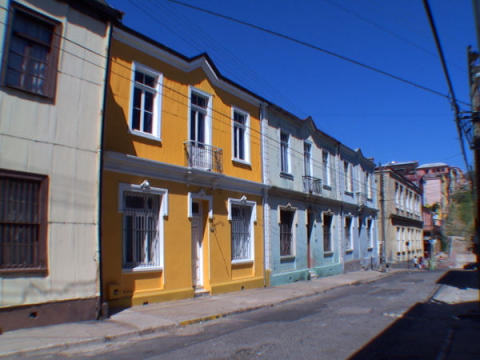December 14, 2006 - 06:46

 The hill where we´re living in Valparaiso was in a black out (for much-needed electrical repairs) from noon til 6 p.m. on Sunday afternoon, so we didn´t actually hear about Pinochet´s death (or all the celebrations going on in the plain below) til the following morning — but we sure heard about it then. The newspaper had a good 40pp. of coverage, two days running (down to 8 pp/day now). Our teachers — one of whom spent twenty years living in exile in Denmark -- could talk of nothing else (so much for interactive pedagogy!) on Monday morning. What I´ve picked up from these experiences, so far, are three things:
The hill where we´re living in Valparaiso was in a black out (for much-needed electrical repairs) from noon til 6 p.m. on Sunday afternoon, so we didn´t actually hear about Pinochet´s death (or all the celebrations going on in the plain below) til the following morning — but we sure heard about it then. The newspaper had a good 40pp. of coverage, two days running (down to 8 pp/day now). Our teachers — one of whom spent twenty years living in exile in Denmark -- could talk of nothing else (so much for interactive pedagogy!) on Monday morning. What I´ve picked up from these experiences, so far, are three things:
- This is a society deeply invested in the cult of personality. There are large men here: Neruda was one, Pinochet another. For me, all the focus on the death of this old man (who committed many crimes against humanity) indicates a disinclination of Chileans to look @ the reasons their society accepted a dictatorship for so many years. There is something here (as in Guatemala) that wants a leader.
- This is also a society still very deeply divided. Whether you find yourself in the midst of mourners or celebrators depends on what neighborhood you live in.
- There are still huge silences here; although politics are discussed intensely among friends, there is a hesitation — which oftimes reaches the level of a refusal — to talk about one´s political opinions with people one doesn´t know well (like visiting noramericanos). Our teachers tell us that they still feel a fear when appearing in public spaces. So far, in other words, Chile has failed to develop the habit—so necessary to democracy--of discussing difference openly.
the hills of this city are filled with Victorian mansions in uncanny tonalities. As Manuel Pena Munoz, the author of Dreaming Valparaiso, says, ¨they manage to create a feeling of magic and expectation amidst a world amazingly recupterated by the miracle of color.¨ In a place with such an extraordinary palette, a place where "all colors are possible" -- a place which is chaotic and dis-ordered in design (none of the gridwork of most Spanish and Spanish American cities), a place where there is always a vista of the sea--I have to believe that it is possible that all points of view might also be expressed.

Comments
Valparaiso
Submitted by Anonymous (not verified) on August 2, 2007 - 17:39 Permalink